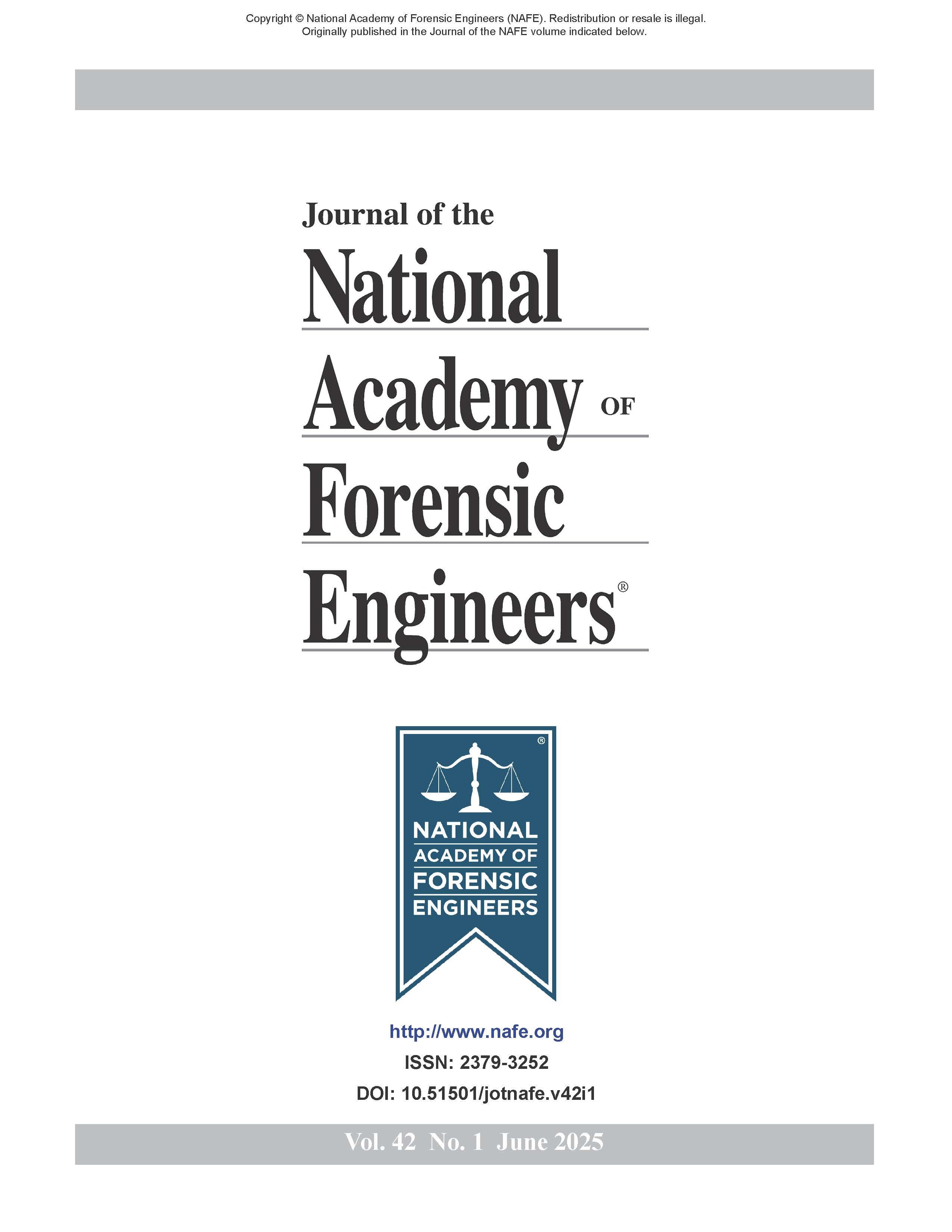Assessing Weather Event Damage in Forensic Engineering: Data Sources and Challenges
DOI:
https://doi.org/10.51501/jotnafe.v42i1.887Keywords:
Hail, tornado, forensic engineering, forensic meteorology, weather, weather event, damage assessment, meteorological data, NOAA, win, NCEI, NCEI-SED, SPC-LSR, NWSAbstract
Forensic engineering evaluations often involve assessing damage from weather events such as thunderstorms, tornadoes, and hurricanes. A crucial aspect of these evaluations is verifying whether the reported weather event occurred on or around the specified date and determining relevant meteorological parameters from the available historical data. Two primary sources of historical meteorological data are the National Oceanic and Atmospheric Administration (NOAA) National Weather Service’s Storm Prediction Center Local Storm Reports (SPC-LSR) and the National Centers for Environmental Information Storm Events Database (NCEI-SED). These databases rely on reports from various sources and may sometimes provide imprecise or inconsistent data. Therefore, forensic engineers should not rely solely on these sources but instead use them in conjunction with data or observations from multiple other sources.
References
Storm Prediction Center, “Storm Prediction Center Severe weather summaries.” [Online]. Available: https://www.spc.noaa.gov/climo/online/. [Accessed: Aug. 28, 2024].
National Oceanic and Atmospheric Administration, “Storm Events Database | National Centers for Environmental Information.” [Online]. Available: https://www.ncdc.noaa.gov/stormevents/. [Accessed: Sep. 8, 2024].
National Oceanic and Atmospheric Administration, “Storm Prediction Center Frequently Asked Questions (FAQ): Section 6.1.” [Online]. Available: https://www.spc.noaa.gov/faq/. [Accessed: Sep. 8, 2024].
National Oceanic and Atmospheric Administration, “Storm Events Database - FAQ | National Centers for Environmental Information.” [Online]. Available: https://www.ncdc.noaa.gov/stormevents/faq.jsp. [Accessed: Sep. 8, 2024].
National Oceanic and Atmospheric Administration, “Storm Events Database | National Centers for Environmental Information.” [Online]. Available: https://www.ncdc.noaa.gov/stormevents/. [Accessed: Sep. 8, 2024].
National Oceanic and Atmospheric Administration, “Storm Events Database - FAQ | National Centers for Environmental Information.” [Online]. Available: https://www.ncdc.noaa.gov/stormevents/faq.jsp. [Accessed: Sep. 8, 2024].
S. F. Blair et al., “High-resolution hail observations: Implications for NWS warning operations,” Weather and Forecasting, vol. 32, no. 3, pp. 1101–1119, May 2017, doi: 10.1175/WAF-D-16-0203.1.
National Oceanic and Atmospheric Administration, “Storm Events Database - Event Details | National Centers for Environmental Information: Event Map.” [Online]. Available: https://www.ncdc.noaa.gov/stormevents/eventdetails.jsp?id=451572. [Accessed: Sep. 8, 2024].
National Oceanic and Atmospheric Administration’s National Weather Service, “The Tornado Outbreak of May 20, 2013.” [Online]. Available: https://www.weather.gov/oun/events-20130520. [Accessed: Sep. 8, 2024].
National Oceanic and Atmospheric Administration, “Storm Events Database - FAQ | National Centers for Environmental Information.” [Online]. Available: https://www.ncdc.noaa.gov/stormevents/faq.jsp. [Accessed: Sep. 8, 2024].
National Oceanic and Atmospheric Administration, National Weather Service Instruction 10-1605: Storm Data Preparation, vol. 10–1605, 2021. [Online]. Available: https://www.weather.gov/media/directives/010. [Accessed: Sep. 8, 2024].
National Oceanic and Atmospheric Administration, “SPC Severe weather event review for Wednesday April 28, 2021: Hail Reports.” [Online]. Available: https://www.spc.noaa.gov/exper/archive/event.php?date=20210428. [Accessed: Sep. 8, 2024].
National Oceanic and Atmospheric Administration, “SPC Severe weather event review for Tuesday April 04, 2017: Hail Reports.” [Online]. Available: https://www.spc.noaa.gov/exper/archive/event.php?date=20170404. [Accessed: Sep. 8, 2024].
National Oceanic and Atmospheric Administration, “Storm Events Database - FAQ | National Centers for Environmental Information.” [Online]. Available: https://www.ncdc.noaa.gov/stormevents/faq.jsp. [Accessed: Sep. 8, 2024].
Additional Files
Published
How to Cite
Issue
Section
License
Copyright (c) 2025 Journal of the National Academy of Forensic Engineers

This work is licensed under a Creative Commons Attribution-NoDerivatives 4.0 International License.
All rights © Journal of the National Academy of Forensic Engineers.
Full statement regarding the author's license of copyright to the NAFE is shown on the Copyright section of the Submissions Page.






